Jane Austen fans, unite! It’s time to merge your love of literature with your wanderlust. In other words, one of the Jane Austen tours offered could be just the ticket to…well, a plane ticket to England and a fantastic vacation.
Jane Austen remains one of the most beloved authors in the English literary canon, even more than two centuries after her death. Her timeless works, like Pride and Prejudice, Sense and Sensibility, and Emma, continue to captivate readers with their wit, romance, and keen observations of human nature. Austen’s world, set against the backdrop of England’s stunning countryside, has inspired countless fans to embark on journeys through her settings. The Cotswolds, unfolding with rolling hills, honey-colored stone villages, and quaint charm, offer the perfect landscape to explore Austen’s literary legacy and England’s rich history. (Even if you are just a major fan of all things British and vintage, like Downton Abbey and Bridgerton, this may be the perfect trip for you.)
We’re taking our own group of Jane Austen lovers to tour significant places in her life and legacy. Plus, the Jane Austen Festival in Bath and the gorgeous Cotswolds. Learn more here.
Come learn about why Jane Austen tours can be such a delight. Along the way, we’ll cover how to get there, what to expect weather-wise, and the must-visit sites for Austen enthusiasts. This applies whether your favorite Mr. Darcy is Colin Firth, Matthew Macfadyen, Sir Laurence Olivier, or anyone else!
Jane Austen’s Legacy: Why She Remains a Timeless Favorite
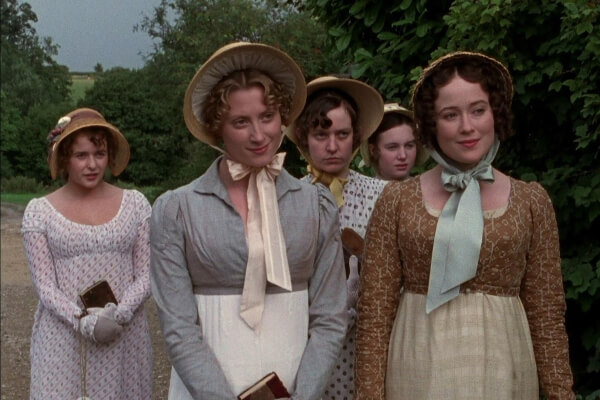
Jane Austen’s novels have transcended time, thanks to their irresistible blend of sharp social commentary, insightful character development, and the romantic tension that keeps readers turning pages. She masterfully depicted the intricacies of 18th- and 19th-century English society, particularly the constraints placed on women and the importance of marriage as a means of securing social standing. “I think I’ve read Pride and Prejudice about a dozen times!” says Jeannie Ralston, Founder and CEO of NextTribe, who leads the company’s Cotswolds trips.
While Austen didn’t live in the Cotswolds, the area embodies the spirit of the serene pastoral England that anchors her novels.
While Austen herself spent much of her life in Hampshire and Bath, her works often evoke the idyllic beauty of the English countryside, which aligns seamlessly with the Cotswolds, a favorite region just an hour and a half or so outside London. Austen never lived in the Cotswolds, but the area embodies the spirit of the serene, pastoral England that anchors her novels. It just the kind of place for long walks through gardens and fields. The region has also served as the filming location for various Austen adaptations, making it a must-visit for fans wanting to experience scenes from their favorite stories.
Jane Austen’s Life and Works: A Brief Overview
Born in 1775 in Steventon, Hampshire, Jane Austen was the seventh of eight children in a lively family that valued education, conversation, and creativity. Growing up in a rural village, Austen had firsthand experience of the genteel society she would later immortalize in her novels. Despite the limitations on women’s opportunities at the time, Austen wrote prolifically over the mere 41 years of her life (she died in 1817), producing six major novels that are still celebrated worldwide. (Incidentally, if you want to visit her final resting place, that would involve a day trip to Winchester Cathedral, about an hour and a half to the south of the Cotswolds.)
In her mere 41 years of life, Austen wrote six major novels that are still celebrated worldwide.
Austen’s works, including Pride and Prejudice, Emma, Sense and Sensibility, Northanger Abbey, Mansfield Park, and Persuasion, focus on the lives, romances, and moral dilemmas of women navigating the social expectations of the Regency period. Her writing is both a critique of the societal pressures of her time and a testament to her wit, intelligence, and understanding of human nature.
The Cotswolds: Where Are They, and Why Visit?
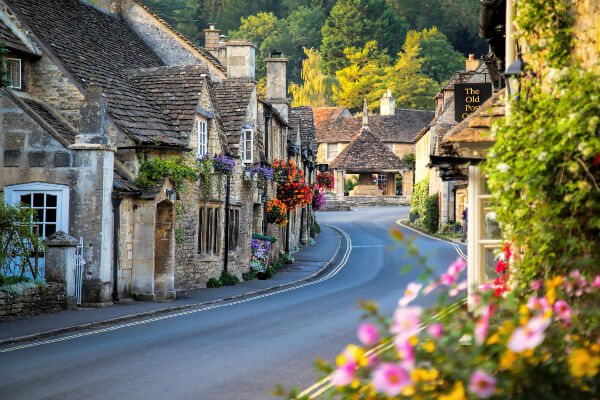
The Cotswolds is a designated Area of Outstanding Natural Beauty (AONB) that stretches across several counties in southwest England, including Gloucestershire, Oxfordshire, and Wiltshire. Known for its quintessential English villages, lush landscapes, stately homes, and historic charm, the Cotswolds is often described as stepping into a bygone era. The region’s limestone cottages and cozy tea rooms beckon to visitors seeking a tranquil escape.
The Cotswolds’ gentle hills, or “wolds,” are perfect for leisurely strolls, and its well-preserved villages evoke the charm of centuries past, making it an idyllic setting for those who wish to immerse themselves in England’s heritage and follow in the footsteps of Jane Austen.
The gentle hills, or “wolds,” are perfect for leisurely strolls, and the well-preserved villages evoke the charm of centuries past.
And, as you travel to the Cotswolds, you might visit the perfectly maintained village of Lacock, owned almost entirely by the National Trust and considered to be among the United Kingdom’s most unspoiled and scenic towns. While some consider it technically three or so miles outside the official Cotswolds border, it’s worth a stop. Scenes from both the Downton Abbey and Harry Potter sagas have been filmed here.
Weather and Best Time to Visit the Cotswolds
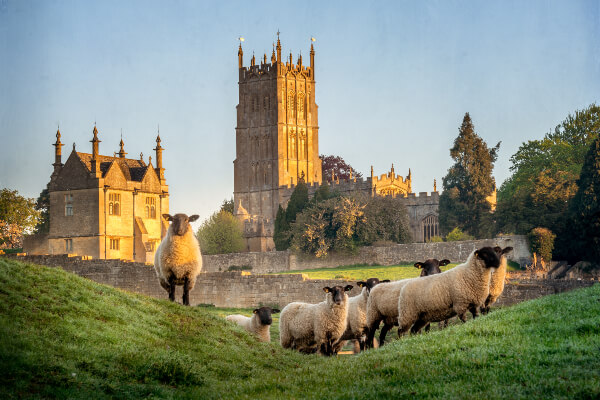
Ready to enter the world of Jane Austen? If you’re Cotswolds-bound, know that the region enjoys a temperate maritime climate, with mild summers and cool winters. Here’s what to expect throughout the year:
- Spring (March to May): A wonderful time to visit, with temperatures ranging from 45°F to 60°F. The countryside blooms with vibrant wildflowers, and the gardens are in full swing.
- Summer (June to August): The warmest season, with temperatures averaging between 60°F to 75°F. This is the peak tourist season, perfect for outdoor activities and exploring the villages, but be prepared for some crowds (perhaps in pretty Austen-esque frocks) and occasional rain.
- Autumn (September to November): The landscape transforms with golden leaves, and temperatures range from 50°F to 65°F. This is a great time for quieter walks and cozy pub visits. By the way, NextTribe’s Jane Austen trip is scheduled for September. “We planned it that way to coincide with the author’s big birthday celebration, hosted annually but this year marking 250 years,” explains Ralston. “It’s an absolute bucket-list event that wild horses couldn’t keep me from!”
- Winter (December to February): Temperatures can drop from around 35°F to 45°F. The holiday season brings festive decorations, and the Cotswolds become a magical winter wonderland.
Spring and autumn can be the best times to visit the Cotswolds, with delightful weather and fewer crowds than in midsummer. Plus the celebration of Austen’s birthday happens every September.
Best Time to Visit: For those planning a Jane Austen-themed tour, spring, and autumn offer the best combination of pleasant weather and fewer crowds.
Read More: “What Is a Weekend?” and Other Memorable Zingers From Downton Abbey
Getting to the Cotswolds from the U.S.
The closest major airport to the Cotswolds is London Heathrow (LHR). From the United States, direct flights to Heathrow are available from major cities like New York, Los Angeles, and Chicago. Once in London, travelers can reach the Cotswolds by train, bus, or car.
- By Train: Direct trains from London Paddington to Oxford, Moreton-in-Marsh, or Cheltenham take about 1-2 hours.
- By Car: Renting a car is recommended for exploring the Cotswolds’ sweet villages at your own pace. The drive from London to the Cotswolds takes about 1 1/2 to 2 hours.
- By Bus: National Express and other coach services also connect London to towns like Oxford and Cheltenham.
Highlights of a Jane Austen Tour
For fans of Jane Austen, exploring the Cotswolds is like stepping into her novels and 19th-century life. Here are the highlights of a Jane Austen-inspired tour:
1. Idyllic Villages: Tetbury and Beyond
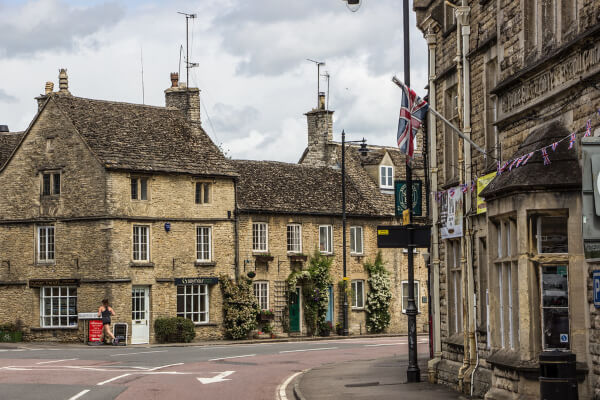
Start your tour in Tetbury, a quintessential Cotswold village known for its antique shops and picturesque streets. Wander through the town and imagine you’ve stepped into a Jane Austen novel. You can conjure up the social gatherings and conversations that she so vividly described in her novels. Other must-visit villages include Chipping Campden, Stow-on-the-Wold, and Broadway, each brimming with historical charm and architectural beauty.
2. Highgrove Gardens

Visit the private gardens of Highgrove, the residence of King Charles III. The meticulously maintained gardens are open to the public for guided tours, showcasing the stunning landscape and authentic period atmosphere that captures the essence of English horticulture. The tranquil gardens are reminiscent of the serene outdoor settings in Austen’s novels.
3. The Historic City of Oxford
Oxford, home to the world-renowned university, offers an educational tour that brings to life the intellectual atmosphere of Austen’s era. Whether on one of those guided walks or solo, explore historic colleges like Christ Church and Magdalen College, admiring the Georgian architecture and imagining the influence of academia on Austen as she wrote her beloved novels.
Austen attended boarding school at Oxford at the tender age of 7, and the university town likely left a lasting imprint on her literary development.
Interestingly, says Ralston, in the spring of 1783, when Jane was seven and her sister Cassandra was 10, the sisters were sent to a boarding school in Oxford. As the sisters were so young, Jane was likely sent to accompany Cassandra. Oxford undoubtedly influenced Jane in many ways. With limited formal education, Jane learned literature from her father and poetry from James, both Oxford scholars. In these ways, the university’s influence left its imprint on Austen.
4. Jane Austen’s 250th Birthday Celebration in Bath
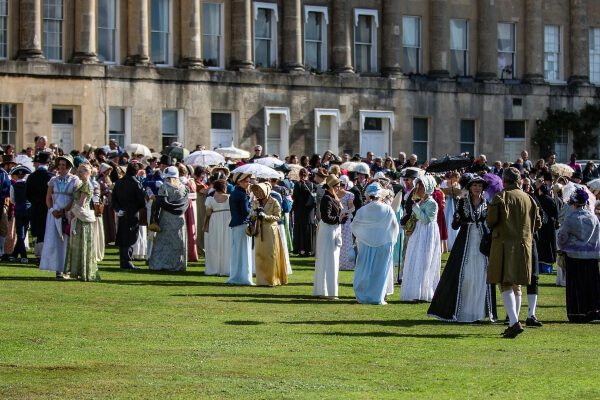
No Jane Austen-themed tour is complete without a visit to Bath, where Austen lived and set two of her novels, Northanger Abbey and Persuasion. Each year, Bath hosts the Jane Austen Festival in September (as noted above), complete with Regency-era costumes, theatrical performances, and even a grand Netherfield Ball where attendees can dress up and dance the night away. So who will your inspiration be? Keira Knightley as Elizabeth Bennet? Gwyneth Paltrow or perhaps Anna Taylor-Joy as Emma?
5. Film Locations
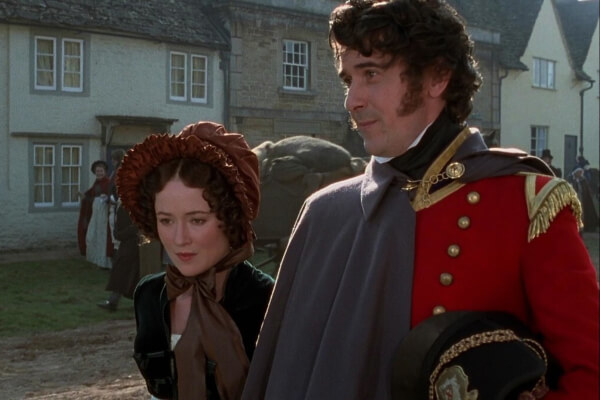
Want to enter Jane Austen’s world and immerse yourself in how (and where!) her famous works were depicted on screen? Several scenes from Jane Austen movie adaptations were shot in the Cotswolds. Film sites like Luckington Court (used as Longbourn in the 1995 Pride and Prejudice) and Lacock Village (featured in Emma and Pride and Prejudice) offer a chance to see iconic settings from your favorite adaptations. Alas, though, you’re not likely to spot Mr. Darcy emerging from the lake.
(Hunting for Basildon Park, which stood in for Netherfield in the 2005 Pride and Prejudice adaptation? You’ll find that perhaps an hour to the east, in Reading.)
Jane Austen Tours: A Note About Fashion
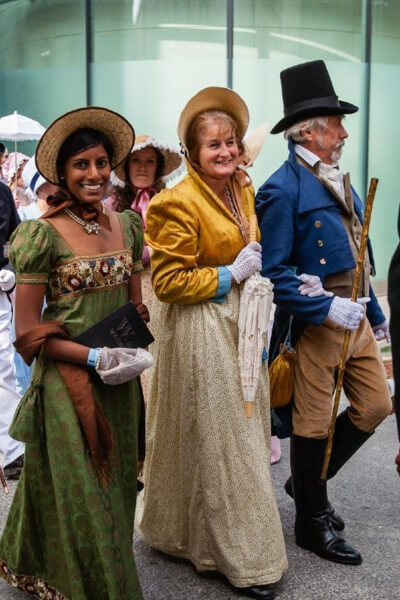
If you’re the sort who can’t imagine a Jane Austen tour without dressing up in antique-style finery, you’ll have a couple of choices. There are places to rent or buy Austen-era outfits, with their lush silks or simple cotton, rustling skirts, and scooped-out necklines. Or you might prefer to bring your own dresses along. Etsy, for instance, has quite an array of what are called Regency dresses with high waists, flattering necklines, and lovely fabrics. Don’t forget your hat and gloves!
Special Food Experiences: English Teas and Local Delights
No visit to the Cotswolds is complete without indulging in the option of a typical English afternoon tea with all its niceties. Many quaint tearooms offer an authentic experience of traditional afternoon teas with scones, clotted cream, jams, those delightful crustless little tea sandwiches, pastries, and steaming pots of good tea. Or book an afternoon tea at one of the posh historic hotels in Bath or Oxford.
Whether enjoyed at a quaint tearoom or posh historic hotel, afternoon tea is a tradition few can resist, with scones, those crustless little sandwiches, and steaming pots of good tea.
Another edible highlight is enjoying a meal at one of the Cotswolds’ local pubs, which serve hearty dishes like shepherd’s pie, fish and chips, and local cheeses.
A Journey Through Time in Jane Austen’s England
Whether you’re a lifelong fan of Jane Austen or simply love exploring England’s historic countryside, a tour of the Cotswolds offers an enchanting mix of literary history, scenic beauty, and timeless charm. From walking in the footsteps of Austen’s characters to enjoying the elegance of English tea, the Cotswolds invites you to experience the magic of old England. And honestly, when else might you have an excuse to don a Regency-style frock and bonnet and wander through a meadow?

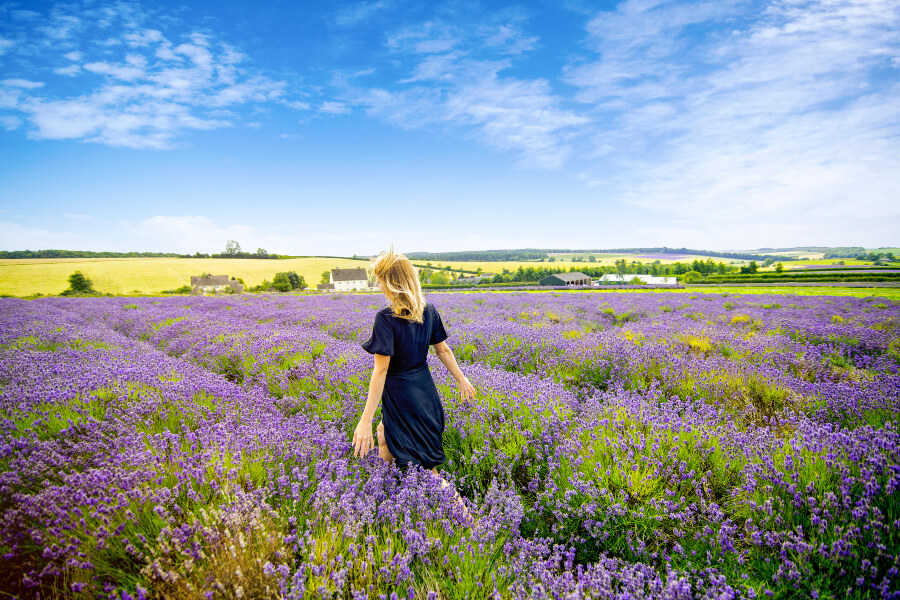





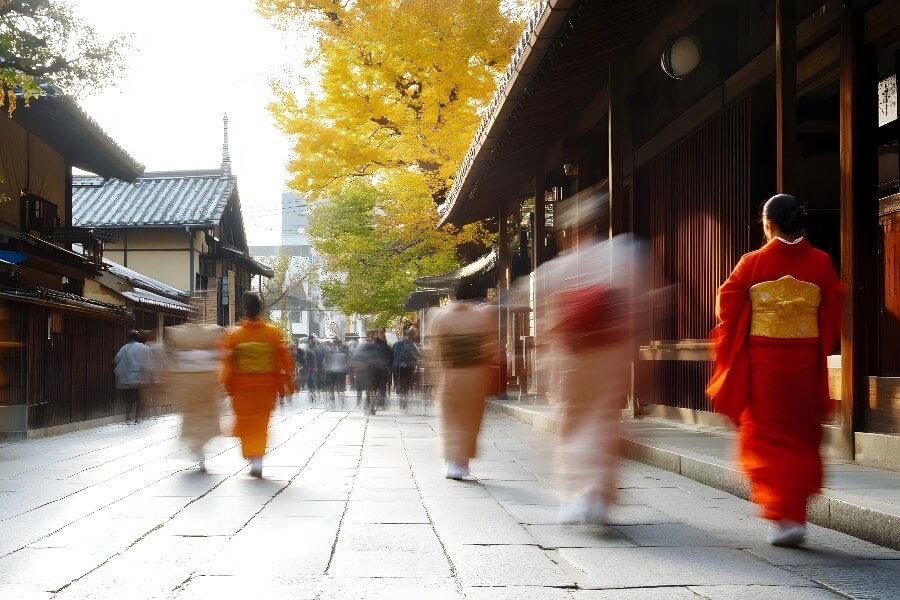















0 Comments